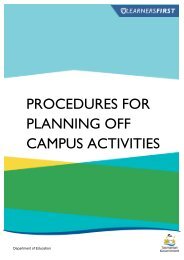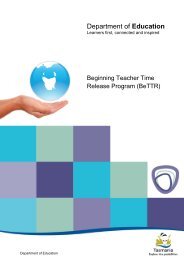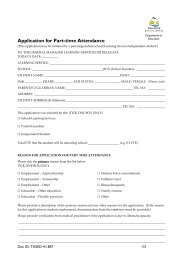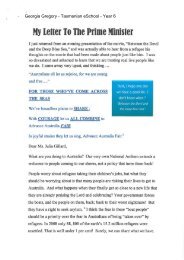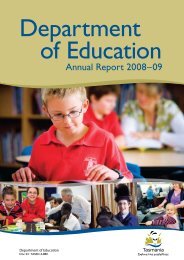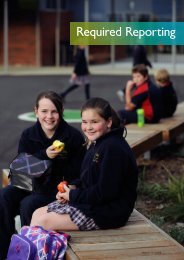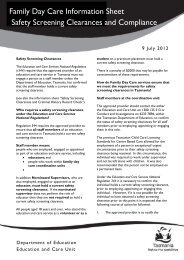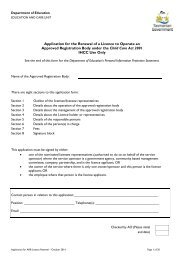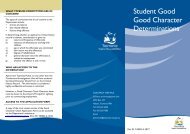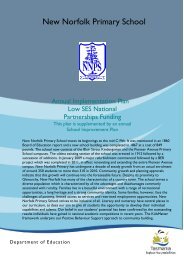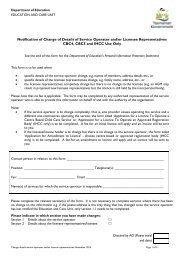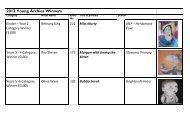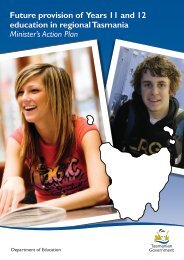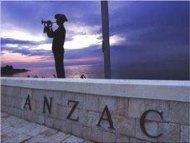Education
DoE Annual Report 2012-2013 - Department of Education
DoE Annual Report 2012-2013 - Department of Education
- No tags were found...
You also want an ePaper? Increase the reach of your titles
YUMPU automatically turns print PDFs into web optimized ePapers that Google loves.
Tasmania, along with other states, has endorsed the<br />
senior secondary Australian Curriculum for English,<br />
Mathematics, Science and History as the agreed and<br />
common base for development of senior secondary<br />
courses. Processes and timelines are being determined<br />
during 2013. Eight curriculum teacher leaders with specific<br />
learning area responsibility across Years 9–12 have been<br />
appointed to provide direct school-based learning area<br />
support with a senior secondary focus.<br />
The department’s Literacy and Numeracy Framework guides<br />
the work of schools in literacy and numeracy. Based on<br />
the framework, every school has an explicit literacy and<br />
numeracy strategy as part of their school improvement<br />
plan so that every child’s literacy and numeracy learning<br />
needs can be supported.<br />
Through the Lead School/Lead Teacher initiative and the<br />
development of the literacy and numeracy resource,<br />
Supporting Literacy and Numeracy Success – a teacher’s<br />
resource for Early Years to Year 12, the department continues<br />
to support teachers to build capacity in literacy and<br />
numeracy teaching and learning. In 2013, the lead teacher<br />
initiative was expanded into Years 11 and 12. Curriculum<br />
teacher leaders support their colleagues in senior<br />
secondary schools with curriculum implementation as well<br />
as supporting literacy and numeracy teaching and learning.<br />
Further commitment to improving the literacy and<br />
numeracy outcomes of students is demonstrated through<br />
the department’s successful needs-based Raising the<br />
Bar (RTB) initiative, which has a particular emphasis on<br />
targeting disadvantage. In 2013, 51 primary and secondary<br />
schools are participating in RTB. This commitment is also<br />
demonstrated through an action research project to<br />
improve literacy and numeracy across Years 5–8. In 2013,<br />
participating schools and their primary school clusters are<br />
exploring how to improve literacy and numeracy with an<br />
emphasis on transition from primary to secondary school.<br />
Whole-school ownership of school improvement plans<br />
and student performance is becoming increasingly<br />
evident as school data is used more effectively and is<br />
integral to school improvement planning processes.<br />
The department is supporting the capacity of teachers<br />
and principals to effectively interpret and use data at the<br />
classroom, school and system level through a range of<br />
services. Examples of these include the development of<br />
systems to collect, manage and report on student data<br />
such as the NAPLAN Toolkit, the provision of a range of<br />
reports around student assessments – including NAPLAN<br />
data, and links to inform teaching and learning strategies.<br />
This increased use of data to inform planning, targeted<br />
intervention and support is a sustainable feature across<br />
all our schools.<br />
Further support for teachers and schools to collect, store,<br />
access and utilise data to inform improvement planning is<br />
the development of a dynamic data warehouse that will<br />
provide accurate, up-to-date data regarding all aspects<br />
of the schools context. Access to this information will be<br />
available to teachers and schools through a secure web<br />
portal which will further enhance schools’ capacity to<br />
monitor students’ outcomes and ensure that schools are<br />
effective and efficient.<br />
The Student Support System (SSS), which was rolled-out<br />
to schools from first term 2013, assists schools to record<br />
observations, actions and strategies used to support<br />
students. Student information follows the students as they<br />
move between schools—enabling principals, teachers<br />
and support staff to further support students with their<br />
learning needs. SSS provides valuable information regarding<br />
the support needs of particular groups of students such<br />
as students with disability, students with complex medical<br />
needs, and students under Care and Protection Orders.<br />
Closing the gap between Aboriginal and non-Aboriginal<br />
student outcomes in Tasmania is one of our top priorities.<br />
We continue to address the national Aboriginal and<br />
Torres Strait Islander education agenda through the<br />
implementation of its Closing the Gap on Aboriginal <strong>Education</strong><br />
Outcomes 2010–2014: a strategy for Aboriginal student success<br />
through school improvement. This strategy outlines a series<br />
of initiatives to improve the success of Aboriginal students<br />
in schools by supporting the particular needs of individual<br />
schools, students and their families. The strategy includes<br />
initiatives aimed at building the capacity of the Tasmanian<br />
education system to deliver quality, inclusive teaching and<br />
leadership for Aboriginal students.<br />
Department at a Glance » Strategic Focus<br />
7




